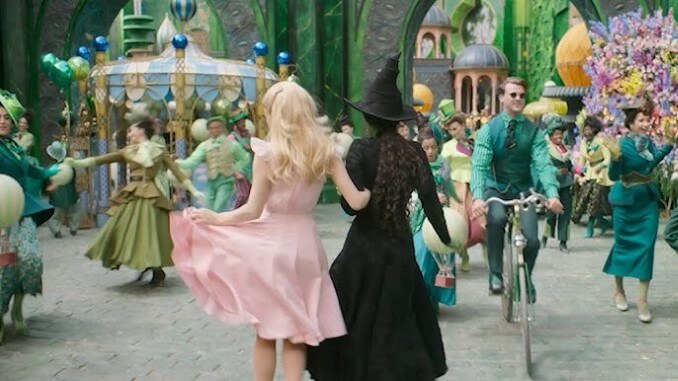Should Movie Musicals Aim Smaller?

Wicked, which was released last November to massive box office success, is a movie musical defined by spectacle and scale. The film lavishes in all the details that couldn’t be fully captured on stage: the ornate halls of Shiz—the prestigious school that both Elphaba and Glinda attend—the lush, cozy Munchkinland, and the glittering streets of the Emerald City. The musical numbers are similarly extravagant, full of complicated choreography with lots of dancers spilling into multiple locations. But despite the costumes, richly saturated colors, and crowded cast, there’s something a bit empty about the Wicked movie that speaks to a larger problem with movie musicals. As they increasingly aim for high spectacle, they emphasize all the ways that the medium of film fails to capture the vitality of a work typically designed for the stage.
A stage musical has a very specific energy that’s tied to live performance and the connection that can form between the actors and the audience. Inevitably, a movie musical will never fully capture the energy of a live performance. This isn’t to say that movie musicals are always doomed to fail. The category, although difficult, has existed for a long time, and includes some of the most popular classic films ever made—think The Wizard of Oz or Singin’ in the Rain. But these movies understand, on some level, that they are different from something performed on a stage, and that their charm comes from someplace else.
Recent movie musicals share Wicked’s impulse toward spectacle: The Color Purple (2023), West Side Story (2021), and In the Heights (2021) all have large casts and dance numbers that attempt to simulate the awe-inspiring effect of live performances. Visually, spectacle makes sense for a movie musical, as the tendency to break out into song and dance already makes plots and characters feel a bit larger than life. In many cases—especially In the Heights, which, like Wicked and its upcoming sequel, Wicked: For Good, is directed by Jon M. Chu—spectacle makes for a thrilling viewing experience. But when a film makes spectacle the primary goal, it risks leaving more important things behind.
Take the classic Wicked song “The Wizard and I,” where Elphaba expresses her dream of meeting the famous wizard, but more importantly exposes a deep-rooted desire for belonging and acceptance after a lifetime of ostracism. In the stage musical, the number is typically staged simply, giving space for the performer who plays Elphaba to fully command the number. The whole point is that the number is a performance; it’s Elphaba’s first opportunity to express herself, undiluted, to a captive audience. In the movie, on the other hand, Elphaba runs around the beautiful Shiz campus, the number culminating as she bursts out into an enormous field and runs to the edge of a cliff. The camera pans out as she delivers the final, triumphant line of the song. Elphaba isn’t allowed to simply perform the song; she must instead be doing something, and the film’s attempt to hide the inherently performative nature of the number by leveraging its grandiose set distracts from what should be an intimate moment.